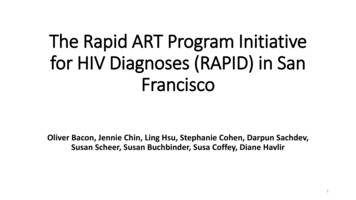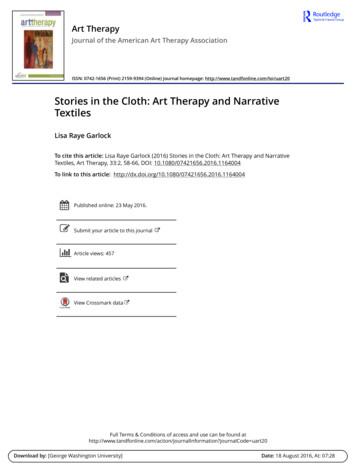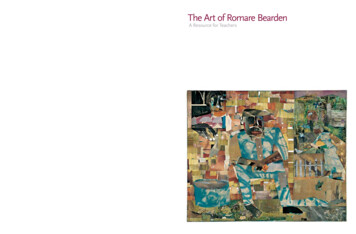
Transcription
The Rapid ART Program Initiativefor HIV Diagnoses (RAPID) in SanFranciscoOliver Bacon, Jennie Chin, Ling Hsu, Stephanie Cohen, Darpun Sachdev,Susan Scheer, Susan Buchbinder, Susa Coffey, Diane Havlir1
Background 2017 WHO Guidelines: On basis of international randomized trials1-6,immediate (within 7 days of diagnosis) ART initiation endorsed for allwilling persons diagnosed with HIV7 2017 DHHS Treatment guidelines: Immediate ART initiation aninvestigational approach8 2018 IAS-USA Guidelines: Immediate ART recommended if safe andfeasible9 2015 San Francisco Getting to Zero (SFG2Z) Consortium: CitywideRAPID (accelerated ART initiation for newly HIV-diagnosed persons)prioritized, after a successful pilot10.2
Objectives Describe ART initiation in all persons newly diagnosed with HIV in SanFrancisco before and during early implementation of the RAPIDinitiative Examine RAPID outcomes stratified by gender, race/ethnicity, age,and housing status Examine RAPID uptake by different HIV care providers3
Methods4
Program Design and ImplementationCitywide RAPID Protocol:All new confirmed HIV diagnoses linked to care 5 working days;At 1st care visit: Baseline labs collected, counseling, medical/psychosocial assessment, ART offered/startedunless medically contraindicated[TFV FTC] [INSTI or DRV/r] with option for 4-drug regimen if HIV infection suspected on PrEPDissemination:HIV clinics identified using HIV surveillance data, trained on RAPID procedures by in-service (2015) andindividual provider detailing (2016)Linkage navigators used RAPID Provider Directory to identify optimal HIV clinic for each newly-diagnosedpatient, by insurance coverage, psychosocial needs.Full protocol and RAPID detailing brochure for clinicians disseminated electronically athttp://www.gettingtozerosf.org/rapid-committee/ and at open quarterly SFGTZ consortium meetings5
Pre-specified Outcomes, 2013-2016Using HIV Case Registry Data from Surveillance Unit at SFDPH, includingsex, age, race/ethnicity, housing status: Time (median days) from Diagnosis to VL 200 c/mL Diagnosis to 1st Care Visit1st Care Visit to ART InitiationART to VL 200 c/mLKruskal-Wallis test for differences in medians 2013-2016 Proportion of new cases linked 5 days AND started ART 1 day Rapid ART initiation by Care Site (public vs. private) INSTI use in 1st ART6
Collection of HIV Surveillance data New HIV cases identified through active and passive surveillance At initial case report: HIV serology, HIV RNA, CD4, sociodemographics,date of ART, date of diagnosis, sites of diagnosis and care Systematic chart review at 6-18 month intervals: HIV RNA, CD4, dateof ART, any data missing from initial case report Completeness of case and laboratory reporting 95% Data not systematically collected: mental illness, substance use All data de-identified for this analysis7
Results8
Study Population: New HIV Diagnoses 2016 -2013CategoryAllMaleFemale13-29 years oldWhiteBlackLatinoAsian/Pacific IslanderHomeless2013 N (%)399 (100)361 (90)27 (7)130 (33)178 (45)51 (13)100 (25)51 (13)30 (8)2016 N (%)265229 (86)29 (11)96 (36)97 (37)34 (13)73 (28)47 (18)29 (11)9
Linkage to Care and ART Initiation Following HIV DiagnosisMetricDiagnosed (%)2013201420152016399329295265In Care (%)372 (93)318 (97)282 (96)258 (97)Started ART (%)311 (78)276 (84)244 (83)215 (81)ART included INSTI (%)145 (47)203 (74)195 (80)159 (74)23 (6)45 (14)50 (17)80 (30)Met RAPID definition (%)**Both diagnosis to care w/in 5 days AND ART w/in 1 day10
Median Time to Care, ART, and Virologic SuppressionMetric201420152016372 (93)318 (97)282 (96)258 (97)8775-38%1st Care Visit to ART (days)271761-96%ART to VL 200c/mL (days)70535038-46%134927761-54%In Care within 1 year (%)Diagnosis to care (days)Diagnosis to VL 200 c/mL (days)2013%Δ 2013-16 Time from diagnosis to VL 200 decreased significantly in all groups Time from diagnosis to first care visit decreased significantly for males, whites, Latinos, youth (13-29) and thehoused Time from first care visit to ART decreased significantly in all groups Time from ART to VL 200 decreased significantly for males, under 40 y.o., whites, Latinos, Asian/PacificIslanders, and the housed11
Median Time to ART, Virologic Suppression, by GroupDiagnosis to VL 200 c/mL 2912310230-3913389 6275148616066565069696657435771P Value 0.00010.0035 0.0001 0.0001 0.0001 0.00010.0152 0.0001 0.0001 8.5%-51.1%-54.8%-70.3%-57.1%-53.9%First care to ART initiation 8613-292714530-3928217 6Housed256321Homeless2016102003560006P Value 0.00010.0006 0.0001 0.0001 0.0001 0.00010.0008 0.0001 0.0001 100%-100%-100%-76%
ART Initiation Within 5 days of 1st visit, by Care Site% of new patients started on ART 9176215HCO/Univ24 (11)HMO35 (16)PMD29 (13)STD0Safety on of ART starts by Site,20162014201518(8)83(39)Other Public17(8)Out of Jurisdiction9 (4)201613
Summary: What worked, what didn’t During a citywide, multisector initiative to optimize ART initiation: time to first virologic suppression cut by more than half time to ART cut 96% from 27 days to 1 day significant improvements in traditionally vulnerable populations, including racialand ethnic minorities and the homeless disparities remain in some groups RAPID uptake by care providers improved in the public and private health caresectors. 30% of new HIV diagnoses in 2016 started ART 6 days from diagnosis sociodemographic analysis of RAPID vs. non-RAPID ongoing 16% of persons diagnosed with HIV in 2016 were not started on ART sociodemographic analysis of nonstarters vs. ART starters ongoing14
Thoughts on Using Surveillance data forProgram Planning, Evaluation Routinely collected HIV surveillance data, plus case-based review(ART start date): Central to map care pathway and identify areas for improvement Used to prioritize traditionally vulnerable populations for programmaticsupport Ecological data: cannot show an association between program and outcomes Collects a limited number of variables . .But collects data rigorously, completely, systematically15
AcknowledgmentsSF G2Z Consortium and RAPID CommitteeHiroyu HatanoVirginia CafaroChris PilcherSusa CoffeyBrad HareDiane JonesJanet Grochowski ARCHES (Applied Research, Community HealthEpidemiology, and Surveillance)Center for Learning and InnovationSFDPH LINCS Team and SF City ClinicErin AntunezSharon PennPatrick KinleyJason ChadderdonIvette Vazquez-LopezAndy ScheerPHAST and RAPID Teams at the UCSF Division ofHIV, ID, and Global Health at ZSFGHSandra TorresLizzie LynchChristy CampFabiola CalderonClarissa Ospina-NorvellMonica Gandhi16
References1.Lundgren J and the START INSIGHT Study Team. Initiation of Antiretroviral Therapy in Early Asymptomatic HIV Infection. New Engl J Med. Aug 272015;373(9):795-807.2.TEMPRANO ANRS 12136 Study Group. A Trial of Early Antiretrovirals and Isoniazid Preventive Therapy in Africa. New Engl J Med. 2015 Aug27;373(9):808-22.3.Cohen MS, Chen YQ, McCauley M, et al. Antiretroviral Therapy for the Prevention of HIV-1 Transmission. New Engl J Med. 2016 Sep 1;375(9):8309.4.Rodger AJ, et al. Sexual Activity Without Condoms and Risk of HIV Transmission in Serodifferent Couples When the HIV-Positive Partner Is UsingSuppressive Antiretroviral Therapy. JAMA. 2016;316(2):171-181.5.Rosen S, Maskew M, Fox MP, Nyoni C, Mongwenyana C, Malete G, et al. (2016) Initiating Antiretroviral Therapy for HIV at a Patient’s First ClinicVisit: The RapIT Randomized Controlled Trial. PLoS Med 13(5).6.Koenig SP, Dorvil N, Dévieux JG, Hedt-Gauthier BL, Riviere C, Faustin M, et al. (2017) Same-day HIV testing with initiation of antiretroviral therapyversus standard care for persons living with HIV: A randomized unblinded trial. PLoS Med 14(7).7.Guidelines for managing advanced HIV disease and rapid initiation of antiretroviral therapy, July 2017. Geneva: World Health Organization; 2017.8.Panel on Antiretroviral Guidelines for Adults and Adolescents. Guidelines for the Use of Antiretroviral Agents in Adults and Adolescents Livingwith HIV. Department of Health and Human Service, October 2017. Available dAdolescentGL.pdf.9.Saag, MS, et al. Antiretroviral Drugs for Treatment and Prevention of HIV Infection in Adults: 2018 Recommendations of the International AntiviralAssociation-USA Panel. JAMA 2018;320(4):379-396.10.Pilcher et al. The Effect of Same-Day Observed Initiation of Antiretroviral Therapy on HIV Viral Load and Treatment Outcomes in a US Public HealthSetting. J Acquir Immune Defic Syndr 2017;74:44–51)17
The Rapid ART Program Initiative for HIV Diagnoses (RAPID) in San Francisco Oliver Bacon, Jennie Chin, Ling Hsu, Stephanie Cohen, Darpun Sachdev, Susan Scheer, Susan Buchbinder, Susa Coffey, Diane Havlir 1. Background 2017 WHO Gu










